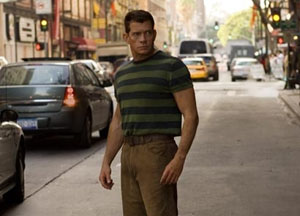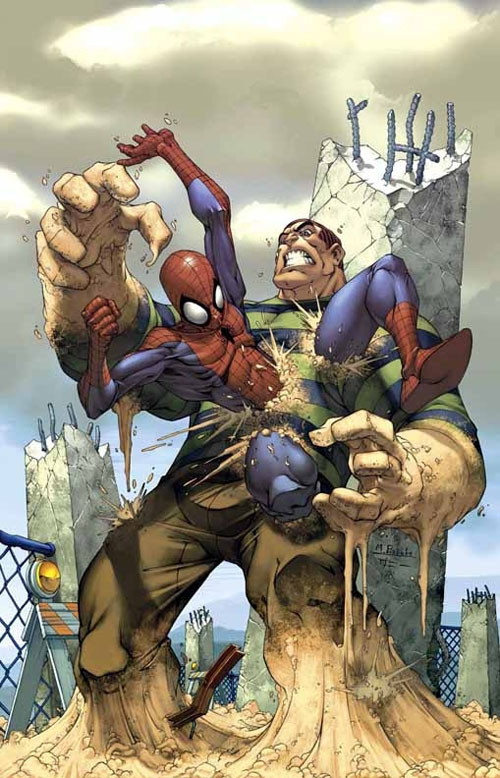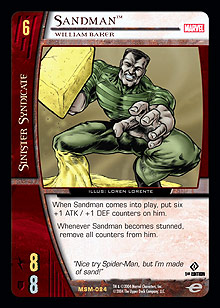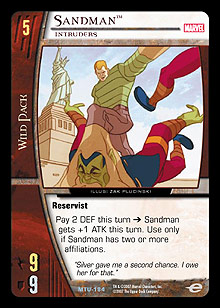If this is your first encounter with Living Ink, then I urge you to check out the previous installments focusing on Spider-Man, Dr. Octopus, Dr. Strange, and Mephisto and school yourself on what this series is all about.
This week in Living Ink, there will be classic themes of villainy, moral conflict, and—ultimately—redemption. While some comic book heroes seem to live in a world of absolute blacks and pure whites, the average person sees in myriad shades of gray. We’re all capable of a bit of good, as well as our fair share of evil, and we all know that the good guy sometimes finishes last. Sometimes, we secretly like it when that happens.
 There’s actually a really long list of heroes who started their careers as villains, including the Avengers’ Hawkeye, Quicksilver, and Scarlet Witch; the X-Men’s Rogue and Juggernaut; Silver Surfer; and even the JLA’s Plastic Man. Still more villains have on occasion put their personal ambitions aside for the common good; Magneto, Dr. Doom, Sabretooth, and Venom are great examples of bad guys who occasionally (albeit very rarely) dabble in heroism. Perhaps the juiciest of all comic book morsels, though, is the hero gone bad. The moral collapse of characters like Hal Jordan, Jason Todd, and Captain America’s one-time sidekick Bucky (appearing as Winter Soldier) make for great reading. Ultimately, fanboys love a good rogue. We especially love heroes who have a dark side and villains who are capable of saving the day.
There’s actually a really long list of heroes who started their careers as villains, including the Avengers’ Hawkeye, Quicksilver, and Scarlet Witch; the X-Men’s Rogue and Juggernaut; Silver Surfer; and even the JLA’s Plastic Man. Still more villains have on occasion put their personal ambitions aside for the common good; Magneto, Dr. Doom, Sabretooth, and Venom are great examples of bad guys who occasionally (albeit very rarely) dabble in heroism. Perhaps the juiciest of all comic book morsels, though, is the hero gone bad. The moral collapse of characters like Hal Jordan, Jason Todd, and Captain America’s one-time sidekick Bucky (appearing as Winter Soldier) make for great reading. Ultimately, fanboys love a good rogue. We especially love heroes who have a dark side and villains who are capable of saving the day.
While most of us understand that “with great power there must also come great responsibility” and would like to think that we’d strive to apply our extraordinary powers for the betterment of mankind, I think the truth is that a lot of us would discover that “absolute power corrupts absolutely.” Kermit the Frog tells us that it’s not easy being green, but I think that Spider-Man, with all the trials he has faced over the past forty years, has taught us that it’s even harder to be a hero.
That brings me to Sandman, a.k.a. William Baker, a.k.a. Flint Marko. While the bulk of his career has been spent as a Spider-Man villain and one of Marvel’s many thugs for hire, Sandman has also spent some time on the side of angels. As far as morally conflicted characters go, Sandman is one of comicdom’s most compelling. He has gone full circle from being a vile villain to a respected hero and then back to being a violent criminal again.
Yet another iconic character created by writer Stan Lee and artist Steve Ditko, Sandman first appeared in The Amazing Spider-Man #4 in September 1963. Sandman has the ability to transform his body into sand and alter its density and shape. He can absorb sand from nearby areas, such as a beach or desert, to increase his size and mass, and can reconstitute his body if damaged. His main method of using these powers in combat is to transform his arms and hands into melee weapons, such as maces or sledgehammers, but he occasionally uses his powers to encumber an opponent (see Sand Trap) or even drown them.

While it might seem easy to dismiss the threat Sandman poses for heroes like Spider-Man, it should be noted that his strength is estimated as on par with the Thing. This means that his powers are roughly the equivalent of two members of the Fantastic Four (as his shape-changing abilities are not completely dissimilar to Mr. Fantastic’s stretching powers). Does that make him sound more threatening? Scarier still, Sandman has turned to glass when exposed to extreme heat. Though initially frozen in this solid state, once shattered he was able to control his glass form. Needless to say, Sandman is one of the biggest hitters in Spidey’s rogue’s gallery, and is an adversary to be feared and respected.
Sandman is yet another villain with a tragic past. Abandoned by his father when he was only three, William Baker grew up in poverty with his mother. It didn’t take long for Baker to turn to crime as a means to help support his family. His cheating ways eventually cost him a chance to gain an education when he was expelled from school. As far as tough childhoods go, Sandman arguably has some compelling excuses for winding up on the wrong side of the proverbial tracks. Baker soon found work as a mob enforcer and descended fully into a life of crime and violence.
Seemingly ashamed of his criminal ways, he adopted the alias Flint Marko so that his mother would not learn of his villainy, and also to protect her from his enemies.
Eventually, he was arrested and charged for his crimes and was given a prison sentence to be served at the notorious Rikers Island facility. Marko was able to escape, though, and took refuge on a remote beach, where he was exposed to sand that had been irradiated by an experimental reactor. This radioactive sand bonded with his molecular structure and granted him his extraordinary powers.
Continuing his life of crime and enhanced by his sand powers, Sandman soon came into conflict with the young Spider-Man (making him the fourth costumed villain Spidey ever faced). The Web-Slinger used a vacuum cleaner to defeat Sandman in their first encounter . . . a sucky defeat if ever there was one (groans, please).
 Sandman was a founding member of the original Sinister Six, a group of villains led by Dr. Octopus that formed with the specific goal of destroying Spider-Man. After losing that fight and others, Marko decided to avoid Spidey and take on some other Marvel heroes. To that end, he created the Frightful Four and took on the Fantastic Four, but again met with failure.
Sandman was a founding member of the original Sinister Six, a group of villains led by Dr. Octopus that formed with the specific goal of destroying Spider-Man. After losing that fight and others, Marko decided to avoid Spidey and take on some other Marvel heroes. To that end, he created the Frightful Four and took on the Fantastic Four, but again met with failure.
Partnering with Hydro-Man, Sandman renewed his vendetta against Spider-Man, and at one stage the two villains merged into a single, giant, unintelligent mud monster. Sadly for Marko, though, this also resulted in another crushing defeat.
Reflecting on his abject failure as a human being and a super villain, Sandman then slumped into a deep and dangerous depression. It was at this point that he was counseled by the Thing. Offering Marko support and encouraging him to refocus his energies on doing good, the Thing helped Sandman reinvent himself as a hero.
In his first attempt to help Spider-Man in a heroic capacity, Sandman rescued the Wall-Crawler and Silver Sable from a newer incarnation of the Sinister Six. Silver Sable, CEO of Silver Sable International and the founder of the usually heroic mercenary group the Wild Pack, was impressed by Sandman’s performance in that fight and recruited him as a freelance operative.
Marko later joined a heroic group called the Outlaws, which was comprised of a number of other reformed Spidey enemies such as Prowler, Rocket Racer, Puma, and Will O’ The Wisp. This could be seen as the stepping stone that propelled Sandman into the super hero Big Leagues, as he soon joined the Avengers as a reserve member. Compiling an impressive resume of righteousness, Marko then became a full-time member of the Wild Pack and went on to lead one of its sub-groups, the Intruders.
Unfortunately, Sandman then returned to a life of crime. Initially claiming that he had faked his heroism, it was later revealed that the villainous Wizard used a mind-controlling device to manipulate Marko. Even as a villain, though, Sandman seemed to adhere to a higher moral code than most villains and rarely killed.
He went on to rejoin a new incarnation of the Sinister Six, which included Venom. Venom, though, only joined the group to ensure that no one else killed Spider-Man (dig that crazy logic), and in a confrontation with Sandman, he unceremoniously tore off a piece of his sand form and ate it. This seemingly destabilized Marko’s molecular structure and he began to deteriorate. While blaming Spidey for all of this misfortune, Sandman still asked the hero to contact his mother for him. He said he was genuinely sorry that he had failed as a super hero, and then crumbled into a pile of sand.
In a bizarre twist, Marko’s sentience merged with a nearby beach where his sand eventually washed up. The beach then started absorbing people in an attempt to reconstitute Sandman’s body. This was semi-successful, but as a result of trying to absorb so many different consciousnesses, the beach spread out and eventually spawned numerous individual versions of Sandman, each representing a different aspect of Marko’s fractured psyche. There was a good Sandman, an evil Sandman, a feminine Sandman, a childlike Sandman, and so on. The evil Sandman absorbed a number of the other versions, but the good Marko refused to rejoin his worse half, pleased to be rid of all of the bitterness, anger, and violence. Not able to exist as a solitary being, though, the good Sandman lost his cohesiveness and crumbled into nothingness. While not strictly as malicious as the purely evil version, the new, single Sandman was no longer held in check by Marko’s conscience and inherent benevolence. He was truly and fully a villain.
While the life and times of Flint Marko are a veritable rollercoaster of morality, I find it hard not to feel compassion for the character. He is a perennial loser who never catches a break. With a bit more luck on his side, I like to think that Sandman could have been one of the greatest heroes in the Marvel universe.
Currently, I am really looking forward to seeing Thomas Haden Church portray the character on the big screen in the highly anticipated Spider-Man 3 film. Sandman might not be the best-known baddie in Spider-Man lore, but I’m hoping that he will prove to be one of the most interesting and visually spectacular characters in the trilogy.
In Vs. System, Sandman has been graced with only two versions to date, but fittingly, one represents Sandman the villain and the other represents Sandman the hero.
 Sandman, Intruders is a Wild Pack 5-drop in the Marvel Team-Up expansion. While in the past I have proposed that lower-costed character cards usually represent that character at an earlier point in their existence, this Sandman is one of the exceptions. Clearly representing Flint at the time when he was leading the Wild Pack’s super-human group, the Intruders, this card is a more modern take on the character. Sandman comes with spot-on average ATK and DEF stats for his recruitment level, but his payment power allows him to reconstruct his stats for greater offensive potential. Throwing caution to the wind, he can boost himself to 13 ATK. As a mercenary, though, Sandman is reluctant to lift a finger without the promise of a payday, so you can only use his power if he has been hired onto another team. Viewing the card this way, I think that Sandman, Intruders is an excellent representation of the heroic Flint Marko.
Sandman, Intruders is a Wild Pack 5-drop in the Marvel Team-Up expansion. While in the past I have proposed that lower-costed character cards usually represent that character at an earlier point in their existence, this Sandman is one of the exceptions. Clearly representing Flint at the time when he was leading the Wild Pack’s super-human group, the Intruders, this card is a more modern take on the character. Sandman comes with spot-on average ATK and DEF stats for his recruitment level, but his payment power allows him to reconstruct his stats for greater offensive potential. Throwing caution to the wind, he can boost himself to 13 ATK. As a mercenary, though, Sandman is reluctant to lift a finger without the promise of a payday, so you can only use his power if he has been hired onto another team. Viewing the card this way, I think that Sandman, Intruders is an excellent representation of the heroic Flint Marko.
Sandman, William Baker was arguably the biggest 6-drop in Vs. System when he was released in the Web of Spider-Man set. Only Hulk, New Fantastic Four rivaled him in terms of raw stats. Essentially a 14 ATK / 14 DEF character, this Sandman card demonstrates how strong he can be in combat, putting him rightfully between Thing, Heavy Hitter and Thing, The Ever-Lovin’ Blue-Eyed Thing in terms of punching power. Being more or less a blunt instrument of combat with no spectacular payment powers, this Sandman reflects the fact that Sandman was little more than a thug early in his career. He was also regularly out-smarted by his adversaries and rarely found himself on the winning side of a battle, so making his big stats dependant on not stunning and on retaining his counters demonstrates that a smart opponent can potentially pull the rug right out from under him.
Both versions of Sandman are great representations of his comic book persona, but I personally hope to see more versions of the character in the future to help further flesh out his rich back-story. Maybe a little scene-stealing in the Spider-Man 3 movie can catapult Sandman back to popularity and more kudos.
Pro Circuit Sydney
In conclusion, instead of providing a reading list this week, I want to indulge in a short recap of my PC: Sydney experience. Prepare for some gushing.
Being married with an oppressive mortgage, it is unlikely that I will ever have the opportunity to travel overseas to participate in our game’s top level of competition, so having a Pro Circuit virtually in my backyard (just three short hours from my home city) was huge for me.
While I’m not the most competitively focused player, I nonetheless set myself the goal of reaching Day 2. Spurning net decks against all reasonable advice, I was one of the four players running the Thor / Nega-Bomb deck, which was officially dubbed “The Shotgun” (although I personally favor the name “Jank Hammer”). I had a blast playing the deck and managed to squeak into Day 2 with a 5-4 record, finishing up in 57th place at the end of the tournament.
Playing in a Pro Circuit really was a dream come true and there were a few people who helped to make it a truly amazing experience. I’d like to thank publicly my good friend and teammate Scott Ward, who designed “The Shotgun” and weathered over four weeks of me and everyone else trying to talk him out of playing it. In the end, he held out long enough to work out all the kinks (or just flat out proved our criticisms wrong), and then converted most of us over to the deck when it became apparent that PC: Sydney might be a predominantly hidden metagame. Similarly, the other members of my team, the A.C.T. Inmates, made my trip to the big show an unforgettable experience.
I was thrilled to see my close friend Kerryn Rubin of Melbourne finish 8-1 at the top of the Swiss after Day 1. Kerryn is, in my opinion, the nicest dude in Vs. System, and he deserved this great result. Similarly, Sydney’s Paul Van Der Werk blew me away with his 8-1 Draft run on Day 2 to make Top 8. Few people have done more for the game in Australia than Paul, so arguably there was no Australian more worthy of a Day 3 berth.
Last but far from least, I really enjoyed meeting and playing against a number of international players. Kim Caton and David Leader could not have been friendlier, and Brian Gates was all class (despite ruthlessly brickwalling my attacks) in the two matches I played against him. I hope Adam Prosak took my suggestion and sampled a meat pie before heading home.
See you in the funny pages,
Michael Pittman
ikeebear@hotmail.com